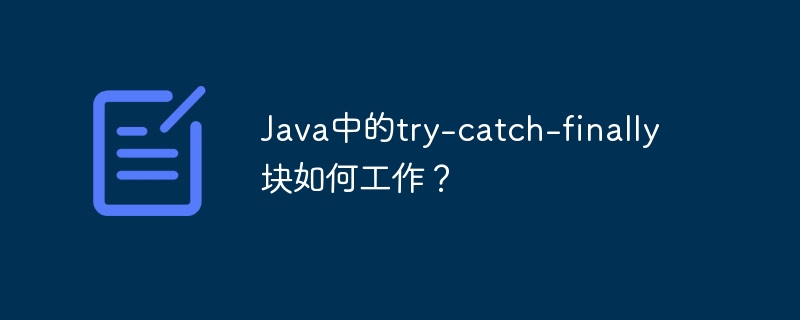Home >Java >javaTutorial >How does try-catch-finally block work in Java?
How does try-catch-finally block work in Java?
- 王林Original
- 2024-04-12 08:00:02759browse
try-catch-finally blocks are used for exception handling: try blocks contain code that may throw exceptions. A catch block handles a specific exception type and there can be multiple catch blocks. The finally block will be executed regardless of whether an exception is thrown, and is often used to release resources.

How does try-catch-finally block work in Java?
try-catch-finally block is an exception handling mechanism that allows us to specify the parts of the code where exceptions may occur so that we can handle these exceptions gracefully and prevent the application from crashing.
Syntax:
try {
// 放置可能抛出异常的代码
} catch (ExceptionName1 e) {
// 如果抛出 ExceptionName1 类型异常,处理它
} catch (ExceptionName2 e) {
// 如果抛出 ExceptionName2 类型异常,处理它
} finally {
//无论是否抛出异常,此处代码始终会执行
}How it works:
- try block: Contains possible Code that throws an exception.
- catch block: Specifies the specific exception types that can be caught. If the code in the try block throws the exception, the catch block is entered. There can be multiple catch blocks to handle different exception types.
- finally block: The code in the finally block will be executed regardless of whether an exception is thrown. Typically used to release resources (such as open files or database connections).
Practical case:
The following code demonstrates how to use the try-catch-finally block to handle file read exceptions.
try {
// 读取文件
BufferedReader reader = new BufferedReader(new FileReader("myfile.txt"));
String line = reader.readLine();
// 使用读取的行执行操作
} catch (FileNotFoundException e) {
// 处理文件未找到异常
System.out.println("文件未找到!");
} catch (IOException e) {
// 处理读取文件时发生的输入/输出异常
System.out.println("无法读取文件!");
} finally {
// 关闭文件,释放资源
reader.close();
}In the above example:
- The try block attempts to read the file and, if successful, uses the lines read.
- catch block handles "FileNotFoundException" (if the file is not found) and "IOException" (if an input/output exception occurs while reading the file).
- The finally block is always executed, the file is closed, and resources are released.
Using try-catch-finally blocks ensures that your application runs gracefully even when encountering exceptions, preventing crashes and providing a better user experience.
The above is the detailed content of How does try-catch-finally block work in Java?. For more information, please follow other related articles on the PHP Chinese website!

